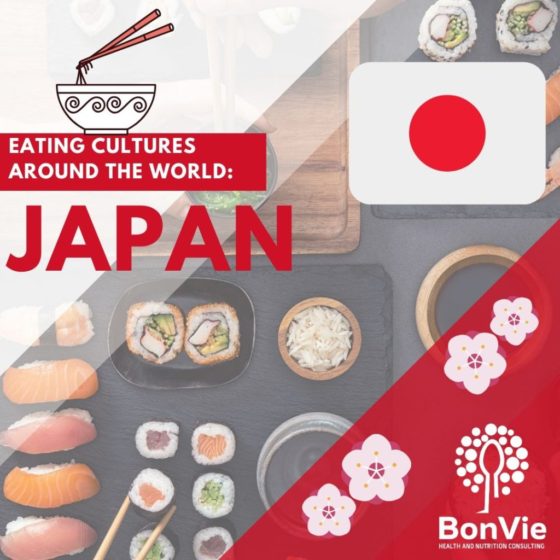
23 Jan Eating Cultures Around the World: Japan
Have you ever looked at the beauty in the way that Japanese food is served? The precision of the knife cuts? The mixing of the colors? The delicate way the food is plated and piled? You may think I’m a little nutty, but I love the beauty of Japanese food. Even a good sushi roll is a feast for my eyes before my taste buds.
Cuisine in Japan is unique both in the way it is prepared and presented, with many dishes stemming from Japan’s long history and influence from nearby countries. Cuisine in Japan is not only healthful and fresh, but also very minimalistic in nature. Japanese chefs are experts in bringing very few ingredients together to make new and delicious combinations.
The Japanese consume very large amounts of fish (which began with the rise of Buddhism and the banning of meat) and rice (a major staple since 300 B.C.). The Japanese have done a superb job sticking to their cultural roots and eating foods that have been typical for many generations!
Today, the Japanese do consume some westernized foods like bread and ice cream. They are also fans of convenience foods, including instant noodles and instant miso soup. Despite the increase in processed foods, overall, the Japanese still maintain healthy diets and lifestyles. In fact, Japan’s obesity rate is only 3.5% compared to 30% in the U.S.
What explains the difference? In addition to the focus on leaner foods as their primary dietary go-to options, portions are much smaller in Japan compared to the U.S. and meals are usually made from scratch by experienced chefs using only the highest quality ingredients.
Another plus? Slower eating! When is the last time you were able to eat quickly with chopsticks? I didn’t think so! Chopsticks are the customary utensil for eating in Japan.
The Japanese tend to eat three meals a day and each meal in Japan is referred as a “gohan”.
A traditional breakfast, or “asa-gohan”, consists of rice, miso soup, fish, rolled omelets (tamagoyaki), dried seaweed or nori, fermented soy beans or natto, and pickled vegetables.
For lunch, rice and noodle bowls are very common. The Japanese enjoy three different types of noodles including udon, soba, and ramen. Bento box lunches are also very popular in school and work environments.
Dinner is the largest meal of the day and can include items such as sushi, sashimi, seafood tempura, and hot pot dishes like sukiyaki and oden. Typically, rice or noodles, miso soup, pickled vegetables, and some sort of meat or fish are the standard fare for dinners at home.
In-season fruit is usually enjoyed as a dessert. Pastries or other sweets are enjoyed in the afternoon with green tea.
Want some other fun facts about Japanese eating?
Sipping soup right out of the bowl is considered proper (Was this frowned upon by your American parents growing up? Mine, too!).
Another custom is that one should never fill their own drinking glass, leaving those at the table to fill each other’s drinking glasses instead (I can get into the chivalry of this!).
It is also custom to not eat and do other things (were they the original geniuses behind mindful and intuitive eating, perhaps?). For instance, driving or walking and eating is considered impolite.
Seasonings in Japan are kept to a minimum, with the most popular seasonings being soy sauce, mirin, and miso which give the cuisine an “umami” flavor. “Umami” is considered our 5th taste and refers to the savory flavor we get from food. The term “umami” derived from Japan, but is becoming popular in the U.S. as a way to describe savory foods.
If you’re into the taste of “umami”, but you’re gluten-free like me, be sure to ask your favorite sushi spot for tamari instead of soy sauce (it’s a gluten-free version that you can enjoy with your wasabi next time). At home, you can cook with tamari or coconut aminos (which give a similar flavor profile). Be sure to always get the low-sodium versions of soy and tamari (they’re delicious, but typically super high in sodium content). Dried seaweed packets are also a go-to yummy “umami” snack that I enjoy on the reg.
The next time you’re about to dive into a good noodle bowl, stir fry, or sushi roll, take a minute to reflect on how cool it is that the Japanese have been enjoying perfecting that for literally thousands of years and how awesome they’ve rocked the flavors with so few ingredients!


No Comments